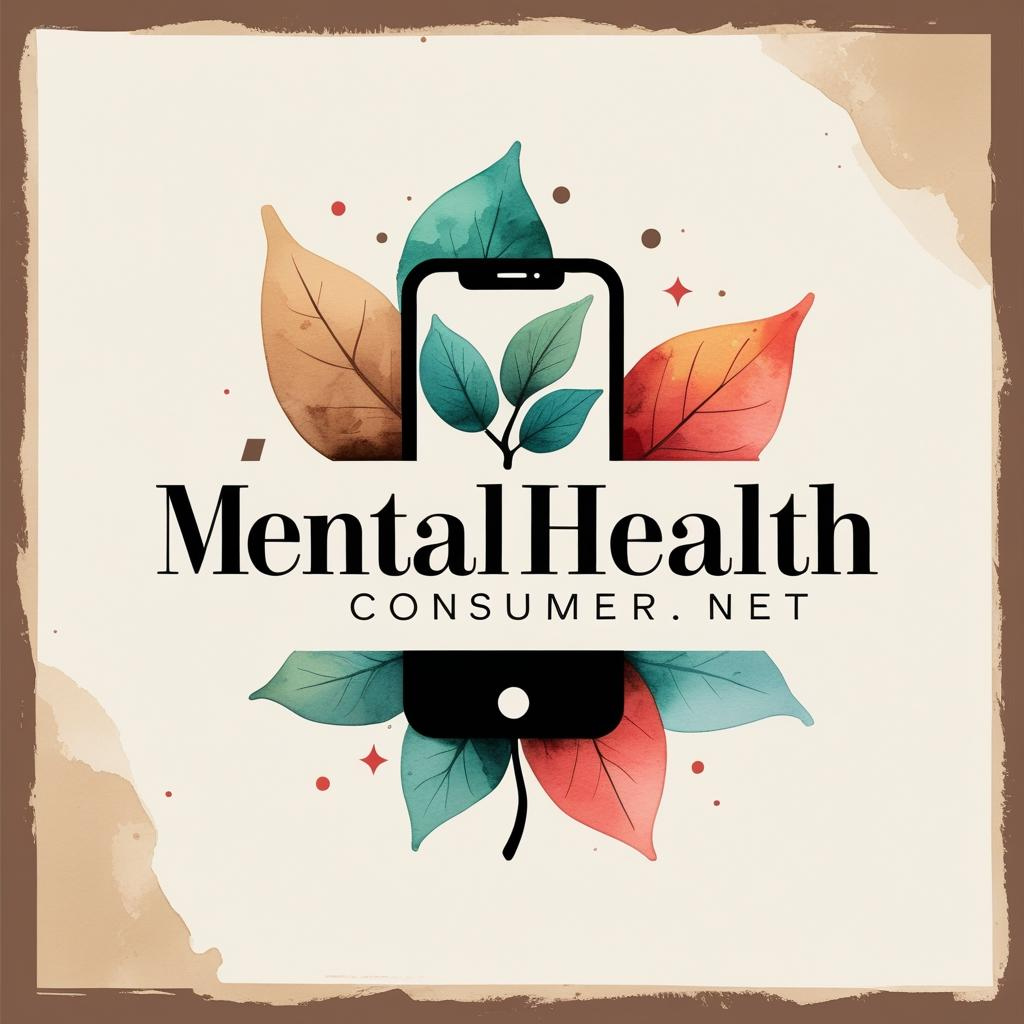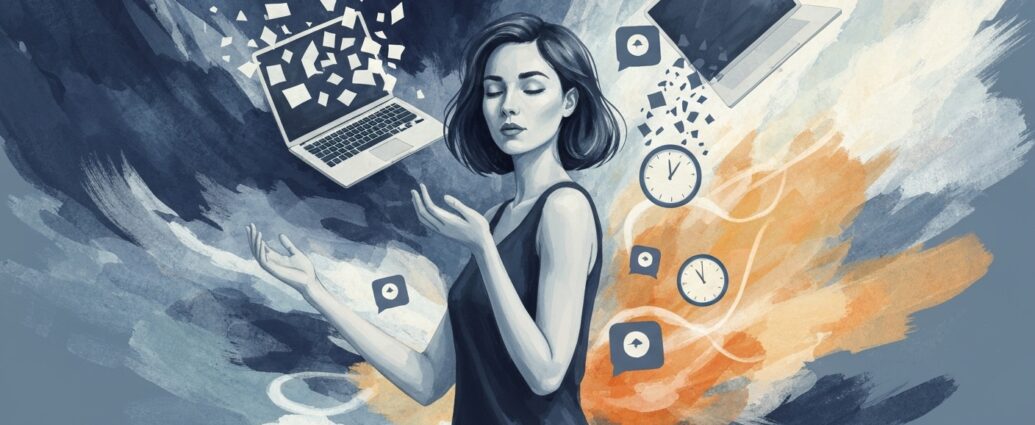The Future of Remote Work: An Honest Guide to Thriving
I remember the first few months of working from home feeling like a strange vacation. I’d roll out of bed, grab my laptop, and start answering emails from the couch. It felt like a win. Fast forward a year, and that “win” felt a lot more like a trap. My workday never seemed to end, my anxiety was buzzing constantly, and the line between “work me” and “home me” had completely dissolved. Sound familiar? The truth about remote work is that its initial promise of freedom has, for many of us, morphed into a state of permanent connection and digital fatigue. The lines between our living room and our office have been blurred for awhile now.
The good news is, we’re not stuck here. The future of remote work isn’t about going back to the office full-time or abandoning the flexibility we’ve gained. It’s about getting smarter and more intentional. It’s about reclaiming our boundaries and learning to thrive in this new landscape. In this guide, we’ll walk through the real trends shaping our work lives, from the rise of hybrid models to the impact of AI. But more importantly, you’ll get practical, step-by-step plans to manage your focus, protect your mental health, and build a work-life balance that actually works.
Where Remote Work Stands Today: The End of the “Wild West” Era
Remember when every company was scrambling to figure out Zoom and Slack? That was the chaotic, reactive phase of remote work. Now, we’re entering a more deliberate era. Companies are no longer just surviving; they are strategizing. According to a 2023 Pew Research Center report, about a third of workers with jobs that can be done remotely are working from home exclusively. Another 41% are on a hybrid schedule. This isn’t a temporary blip; it’s a fundamental shift in how we think about the office.
But this shift brings new challenges. The initial euphoria has worn off, replaced by concerns about career progression, team connection, and, most critically, burnout. The pressure to be “always on” is a significant driver of stress. A survey by the American Psychological Association found that 79% of employees had experienced work-related stress in the month before the survey. The future isn’t about choosing between the office and home; it’s about designing a system where you can be productive and psychologically healthy, wherever you are.
💡 Pro Tip: Stop trying to replicate the 9-to-5 office day at home. Instead of focusing on hours logged, shift your mindset to tasks completed. This small change can free you from the guilt of taking a mid-afternoon walk or running an errand.
Trend 1: The Rise of “Structured Hybrid” and the Need for Intention
The idea of “hybrid work” is evolving. Initially, it meant “work from wherever you want, a few days a week.” Now, we’re seeing the rise of “structured hybrid” models. This means companies are setting specific days for in-office collaboration (e.g., Tuesday-Thursday) and designating other days for focused remote work. This approach attempts to offer the best of both worlds: the connection and spontaneous creativity of in-person work, plus the deep focus and flexibility of working from home.
What does this mean for you? It means you have to be more intentional about how you use your time and space. Your home office can no longer be a chaotic multi-purpose zone. It needs to be a place optimized for focus. Likewise, your days in the physical office should be maximized for connection, not just for sitting in a different chair answering the same emails. This is a great time to explore how to practice digital minimalism, stripping away digital distractions to make room for what truly matters, whether you’re at home or in the office.
Making Your Hybrid Schedule Work For You
- At Home Days: Block your calendar for “deep work” sessions. Turn off notifications and let your team know you’re focusing. Use these days for tasks that require concentration: writing, coding, data analysis, or strategic planning.
- In-Office Days: Prioritize meetings, brainstorming sessions, and one-on-one check-ins. Be present. Leave the laptop at your desk and have lunch with a colleague. Rebuilding those “weak ties” is crucial for wellbeing and career growth, as highlighted by research on social connection in the workplace.
💡 Pro Tip: Create a “commute” ritual for your remote days. A 15-minute walk before you start and after you finish can create a powerful psychological boundary between your work life and your personal life.
Trend 2: The Mental Health Reckoning of Working from Home
We need to have an honest conversation about the mental health impact of remote work. While it can reduce commuting stress, it often introduces new anxieties: loneliness, isolation, and the inability to ever truly switch off. A World Health Organization report highlighted the need for organizational interventions to prevent mental health conditions in the workplace, and this is doubly true for remote environments where managers have less visibility into an employee’s wellbeing.
Digital exhaustion is real. The back-to-back video calls, the constant stream of Slack notifications, and the pressure to signal productivity online takes a toll. We are wired for in-person social cues, and video calls just don’t provide the same neurological satisfaction, leading to what many call “Zoom fatigue.” This is where digital wellbeing practices become non-negotiable. Learning how to set healthy boundaries with your phone is not just a personal wellness goal; it’s a professional necessity for sustainable remote work.
A Simple Plan to Combat Digital Exhaustion
- Schedule “No-Screen” Breaks: For every hour of screen time, take a 5-minute break to look away from all devices. Stand up, stretch, look out a window.
- Audit Your Notifications: Turn off all non-essential notifications on your phone and computer. Do you really need a banner to pop up every time a new email arrives? Probably not.
- Block Your “End of Day”: Put a hard stop in your calendar every day. When that time comes, close your laptop and walk away. Its easy to let one more email sneak in, but defending this boundary is the single most important habit for long-term remote work success.
💡 Pro Tip: If possible, have a “third space.” It doesn’t have to be a separate room. It can be a specific chair, a corner of your kitchen table, or even just putting your laptop completely out of sight in a drawer at the end of the day.
Trend 3: AI and Asynchronous Work are Redefining Productivity
The next big shift in remote work is being driven by technology, specifically Artificial Intelligence and the rise of asynchronous communication. “Asynchronous” simply means communication that doesn’t happen in real-time. Think emails, shared documents, or recorded video messages instead of instant messages or live meetings.
This is a game-changer for focus and work-life balance. An asynchronous-first culture reduces the pressure to be constantly available and allows for more deep, uninterrupted work. It’s also more inclusive for teams spread across different time zones. AI tools, like those from OpenAI or Google, are accelerating this trend. They can summarize long email threads, transcribe meetings, and automate routine tasks, freeing up our mental energy for more complex problem-solving. A recent Stanford study showed that access to a generative AI assistant increased worker productivity by 14% on average.
The challenge is to use these tools wisely. They should be leveraged to create more time for meaningful work and rest, not just to cram more tasks into the same amount of time. The future belongs to those who can master their tools without letting the tools master them.
💡 Pro Tip: Replace one meeting per week with an asynchronous update. Record a short video using a tool like Loom or write a clear, concise summary in a shared document. You’ll be surprised how much time it saves for everyone.
Your Step-by-Step Plan for a Healthier Remote Work Routine
Okay, let’s get practical. Knowing the trends is one thing; changing your daily habits is another. Here is a simple, actionable plan to help you build a more sustainable and fulfilling remote work life. We’ll call it the CUES Method: Cut triggers, Unwind earlier, Environment cues, and Support systems.
- Cut Digital Triggers (The First 7 Days): Your phone and computer are designed to distract you. Your first job is to fight back. Go into your phone’s settings and turn off all notifications except for calls and texts from your absolute favorites. On your computer, close your email and chat apps when you need to focus. Use your device’s built-in tools, like Focus Mode, to automate this. The goal is to make distraction an opt-in, not the default.
- Unwind Earlier (Weeks 2-3): Choose a firm “end time” for your workday and set a recurring alarm for it. When it goes off, you are done. The key is to have a “shutdown ritual.” This could be a 5-minute tidy-up of your workspace, writing down your to-do list for tomorrow, and then closing your laptop. This ritual signals to your brain that the workday is officially over.
- Establish Environment Cues (Week 4): Your brain forms powerful associations with your environment. If you work from your bed, your brain will start to associate your bed with work stress, which can disrupt sleep. Dedicate a specific spot, even if it’s just one end of the dining table, exclusively for work. When you leave that spot, you leave work behind. If possible, avoid bringing your work laptop into your bedroom.
- Build Support Systems (Ongoing): Loneliness is one of the biggest risks of long-term remote work. Be proactive about connection. Schedule a virtual coffee chat with a coworker with no agenda other than to connect as people. Make firm plans with friends and family outside of work. Let your manager and team know what boundaries you are setting so they can help you uphold them.
What to Expect When You Start Setting Boundaries
Here’s a realistic timeline for what you might experience as you implement these changes. Remember, progress isn’t always linear.
- Week 1: This will feel weird and maybe a little stressful. You might feel a sense of FOMO (fear of missing out) from turning off notifications. Stick with it. The initial discomfort is a sign that you’re breaking an old habit.
- Weeks 2-4: You’ll start to notice small pockets of reclaimed time and focus. Your evenings might feel a bit longer. You may feel less “on edge” when you’re not actively working.
- Month 2 and Beyond: Your new routines will start to feel more automatic. You’ll likely feel a noticeable decrease in work-related anxiety and an increase in your ability to be present in your personal life. This is when the real benefits of a balanced remote work life start to show.
Effort & Resources Required
- Time commitment: 15-20 minutes per day to actively manage your schedule, notifications, and shutdown ritual.
- Optional costs: You don’t need to spend money, but some find value in a separate monitor or a comfortable office chair ($100+) or productivity apps like Freedom or Forest (around $5-$40/year).
- Skills: Habit stacking, self-awareness to notice your triggers, and the confidence to communicate your boundaries clearly.
- Ongoing maintenance: A 10-minute review each Friday to see what worked and what didn’t, and to plan your schedule for the following week.
Tools You Can Use on the Devices You Already Own
You don’t need fancy software to build a better remote work life. The most powerful tools are likely already on your phone and computer. Here’s a quick comparison:
| Feature | iOS (Screen Time & Focus) | Android (Digital Wellbeing) | Best For… |
|---|---|---|---|
| App Limits | Set daily time limits for specific app categories (e.g., social, work). | Set daily timers for individual apps. Pauses the app when time is up. | Preventing endless scrolling through email or chat apps after hours. |
| Focus Modes | Create custom modes (e.g., “Work,” “Personal”) that silence specific apps and people. | Similar functionality with “Focus Mode,” which pauses distracting apps you select. | Creating a digital wall between your work and personal life. |
| Scheduled Downtime | “Downtime” feature blocks all but allowed apps during scheduled hours. | “Bedtime Mode” silences the phone and can turn the screen to grayscale. | Enforcing a hard stop to your workday and protecting your evenings. |
Official documentation for these features can be found on the Apple Support and Android Help websites.
💡 Pro Tip: Create a “Work” Focus Mode that only allows notifications from your work-related apps (like Slack and Outlook) and key contacts. Set it to turn on automatically based on your schedule or location. Then, create a “Personal” mode that silences them all.
Quick Takeaways
- The future of work is not fully remote or fully in-office; it’s about being intentional with a structured hybrid approach.
- Protecting your mental health is a non-negotiable part of a sustainable remote work career. Burnout is a systemic issue, not a personal failing.
- Use your “at home” days for deep, focused work and your “in office” days for connection and collaboration.
- Create a “shutdown ritual” to signal the end of your workday. This is the most effective way to build a boundary between work and life.
- Leverage the built-in digital wellbeing tools on your phone, like Focus Modes and App Limits, to automate your boundaries.
- Asynchronous communication and AI are powerful tools to reduce meeting fatigue and increase focus, but they must be used mindfully.
- Connection is key. Proactively schedule social time with colleagues and friends to combat the isolation of remote work.
- If you feel consistently overwhelmed, anxious, or burnt out, it is a sign of strength to seek professional support from a therapist or counselor.
Conclusion: The Future is About Agency, Not Location
I learned the hard way that the freedom of remote work requires an equal amount of discipline. For the longest time, I thought being a “good” remote employee meant being instantly available. The result was a constant, low-grade anxiety and a feeling that I was failing at both my job and my life. The real turning point came when I realized that boundaries aren’t for shutting people out; they’re for letting my best self in, both at work and at home.
The future of remote work isn’t about a fancy new app or a prescribed three-days-in-the-office schedule. It’s about agency. It’s about you taking deliberate control of your time, attention, and environment. It requires us to unlearn the old rules of office life and write new ones that prioritize our wellbeing alongside our productivity. We have to be intentional about what we do and how we do it, regardless of weather we’re at home or in the office.
Start small. Pick one thing from this guide, like setting up a Focus Mode or scheduling a 15-minute “commute” walk, and try it for a week. You will have days where you slip up, where you answer that one last email at 9 PM. That’s okay. The goal isn’t perfection; it’s progress. By taking these small, consistent steps, you can build a remote work life that feels less like a trap and more like the freedom it was always meant to be. And if the feelings of burnout and anxiety feel too big to handle on your own, please reach out to a mental health professional. It can make all the difference.
Frequently Asked Questions About the Future of Remote Work
What is the biggest challenge of remote work in the future?
The biggest challenge will be maintaining strong company culture and fostering genuine connection without the daily, spontaneous interactions of an office. Companies and individuals will need to be extremely intentional about creating opportunities for collaboration, mentorship, and social bonding to combat isolation and keep teams aligned and engaged.
How does remote work affect mental health?
Remote work can be a double-edged sword. It can reduce stress by eliminating commutes and offering flexibility. However, it can also increase risks of loneliness, anxiety, and burnout due to blurred work-life boundaries, digital exhaustion from constant connectivity, and a lack of social interaction. Proactive boundary-setting is essential for protecting mental health.
What’s the best first step to improve my remote work-life balance?
The single best first step is to establish a clear “end of day” ritual. This could be closing your laptop, tidying your workspace for 5 minutes, and then immediately going for a short walk. This physical and mental transition creates a powerful psychological boundary that helps your brain switch off from work mode.
Are the free digital wellbeing tools on my phone good enough?
Yes, for most people, the built-in tools like Apple’s Screen Time and Focus or Android’s Digital Wellbeing and Focus Mode are more than sufficient. They are powerful for setting app limits, scheduling downtime, and filtering notifications. Start with these before considering paid third-party apps.
How long does it take to adjust to a hybrid work schedule?
Typically, it takes about 4 to 8 weeks to get into a solid routine with a hybrid schedule. The first few weeks often feel a bit disjointed as you figure out the logistics. The key is to be consistent with your planning, using your remote days for focus and office days for connection, until it becomes a natural rhythm.



